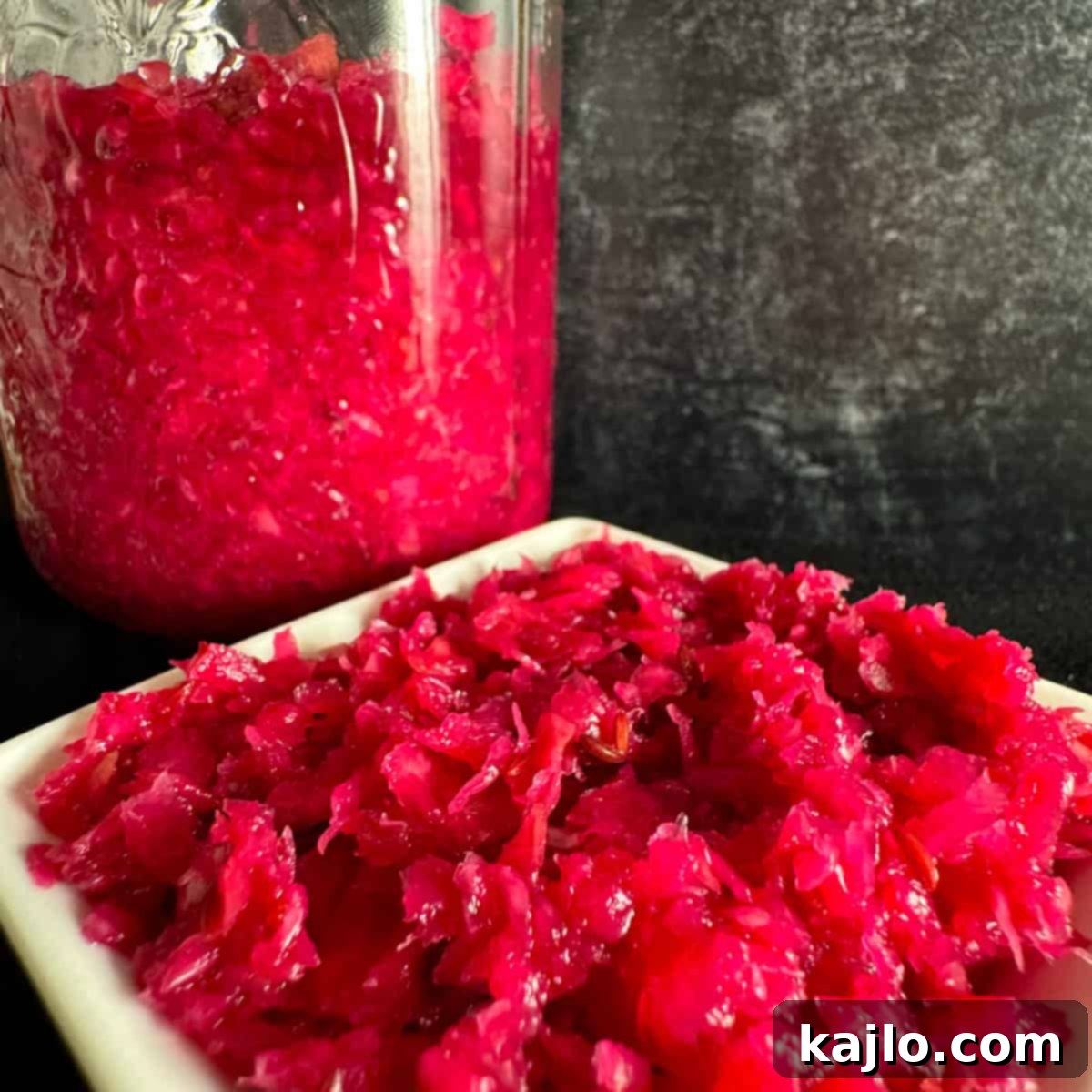Mastering Homemade Red Cabbage Sauerkraut: Your Ultimate Guide to Lacto-Fermentation
Unlock the vibrant world of fermentation with this easy-to-follow recipe for red cabbage sauerkraut. This simple yet rewarding process allows you to create a tangy, probiotic-rich condiment at home using just cabbage and salt. Forget the need for a starter culture; the magic of lacto-fermentation happens naturally! While often associated with its green counterpart, fermented red cabbage offers a remarkably similar tangy flavor and pungent aroma, making it a delicious and visually stunning addition to any meal. We’ll also reveal a clever trick that helps you gauge the success of your fermentation, making this recipe perfect for beginners and seasoned fermenters alike.

Crafting your own sauerkraut is a delightful blend of culinary art and precise science. It embodies the essence of slow food, requiring a touch of patience and a few key pieces of equipment. But rest assured, the unparalleled flavor, impressive health benefits, and sheer satisfaction of making your own fermented red cabbage will make every minute worthwhile.
What a great idea to use red cabbage to see the progress being made!
– Brittany
The Health Benefits of Fermented Red Cabbage
Beyond its delicious taste, red cabbage sauerkraut is a powerhouse of nutrition and beneficial compounds. As a lacto-fermented food, it’s teeming with live probiotics – friendly bacteria that are crucial for a healthy gut microbiome. These probiotics can aid digestion, enhance nutrient absorption, and potentially boost your immune system. Furthermore, red cabbage itself is rich in anthocyanins, powerful antioxidants that give it its distinctive color, and essential vitamins like C and K. Incorporating this vibrant ferment into your diet is a simple step towards supporting overall wellness and experiencing a broader spectrum of flavors.
Many traditional cultures have long revered fermented foods for their health-promoting properties. Sauerkraut, in particular, has been a staple in European diets for centuries, valued not only for its flavor but also for its ability to preserve vegetables through the winter months, providing a continuous source of vitamins when fresh produce was scarce. Today, we appreciate it for these historical benefits, coupled with modern scientific understanding of gut health.
🛒 Red Cabbage Sauerkraut Ingredients
Making fermented red cabbage requires minimal ingredients, making it an accessible and economical culinary project. Here’s what you’ll need:
- 23 ounces red cabbage (approximately one small head; remember to reserve an outer leaf or two for later use)
- 1 tablespoon pickling salt or finely ground sea salt (ensure it’s non-iodized)
- 8 dried juniper berries (optional, but highly recommended for traditional flavor)
- ½ teaspoon caraway seeds (optional, adds a distinct aromatic note)
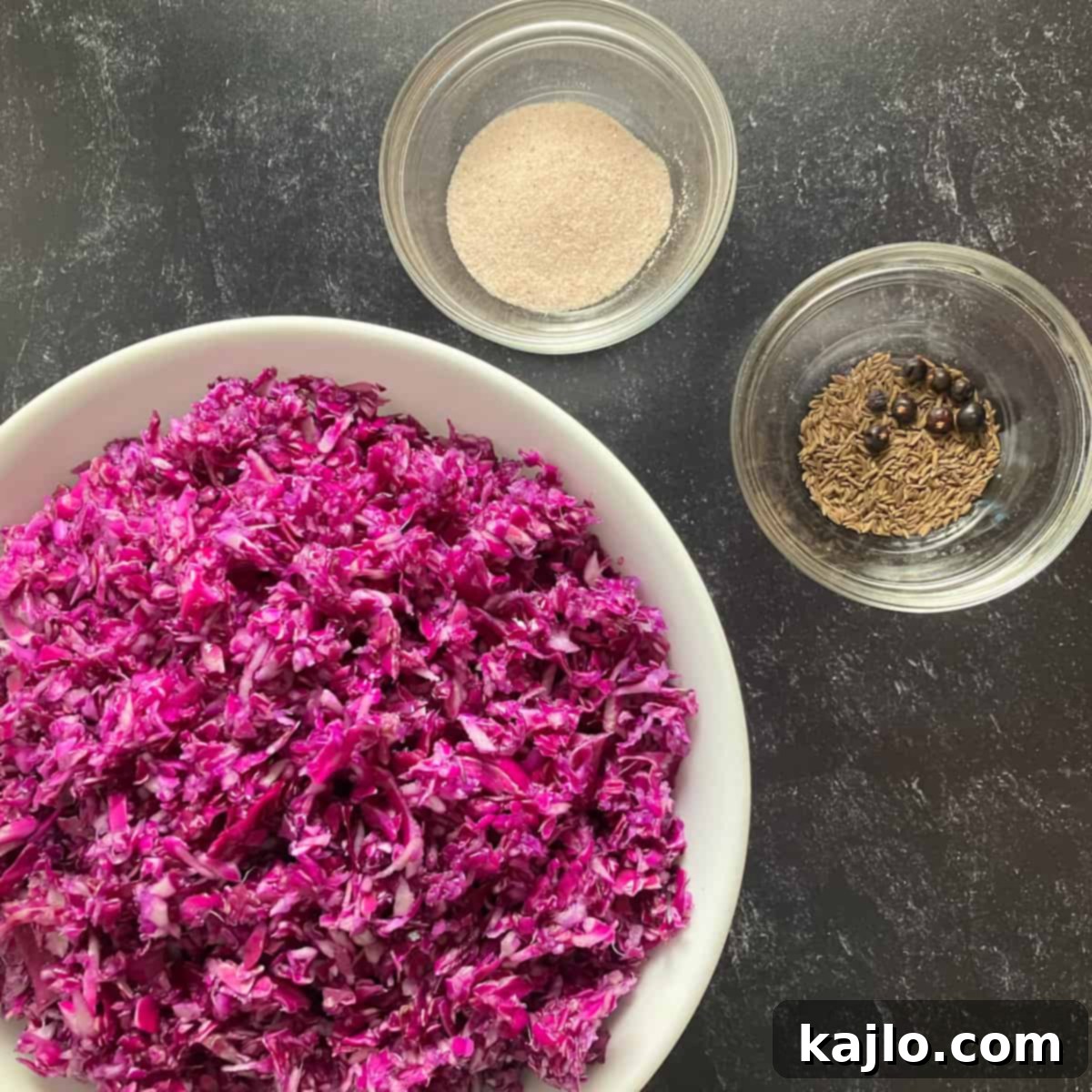
The Critical Role of Salt in Sauerkraut
Salt is more than just a seasoning in sauerkraut; it’s a critical component for both flavor and food safety. Using a volume measurement for salt can be inconsistent due to varying grain sizes. Therefore, weighing both the salt and the cabbage is the most accurate method. A general guideline is to use salt in an amount equivalent to 2% of the cabbage’s weight. For instance, if you have 652 grams of cabbage (about 23 ounces), you would need approximately 13 grams of salt.
Always opt for canning or pickling salt, or a fine-grain sea salt. It’s crucial to avoid iodized salt, as the iodine can interfere with the fermentation process and potentially discolor your beautiful red cabbage, turning it an unappealing shade. While it won’t alter the salt-to-cabbage ratio, it can compromise the aesthetics and sometimes the fermentation itself.
Flavor Enhancers: Spices for Sauerkraut
Juniper berries and caraway seeds are classic additions that impart a distinctive, earthy, and slightly peppery flavor to sauerkraut. However, the world of sauerkraut spices is vast and customizable. Feel free to experiment with other aromatics like black peppercorns, fresh ginger slices, crushed garlic cloves, a pinch of turmeric for extra color and health benefits, mustard seeds, or fresh dill for a different profile. These additions not only enhance the taste but can also contribute their own unique health compounds to your ferment.
Indispensable Equipment for Fermentation Success
While the process of making sauerkraut is straightforward, having the right tools can significantly increase your chances of success and enjoyment. Investing in a few key pieces of equipment will make your fermentation journey smoother and more reliable.
Essential Fermentation Tools
I highly recommend acquiring a basic fermenting kit. At a minimum, this should include **glass jar weights** and **airlock fermentation lids**. These components are fundamental to a successful ferment:
- Jar Weights: These heavy glass discs are crucial for keeping the shredded cabbage submerged beneath the brine throughout the entire fermentation period and even during subsequent storage in the refrigerator. Any cabbage exposed to air is prone to mold growth, which you want to avoid at all costs.
- Airlock Fermentation Lids: These specialized lids allow carbon dioxide, a byproduct of fermentation, to escape while preventing external air and contaminants (like dust, fruit flies, or unwanted bacteria) from entering the jar. This maintains an optimal anaerobic environment for the beneficial lacto-bacteria to thrive, ensuring a safe and successful ferment.
The fermenting kit I used included jar weights, airlock lids, and a wooden tamper. While a tamper is entirely optional—a heavy mallet or even your clean fist can work for pounding—it excels at tightly packing the cabbage into the jar, which is vital for extracting enough brine.
Choosing the Right Container
You’ll also need a wide-mouth quart-sized mason jar. Glass is the preferred material for fermentation because it is non-reactive and easy to clean and sanitize. The USDA explicitly recommends against fermenting foods in most metal containers, with stainless steel being a rare exception. Glass jars also offer the advantage of visual monitoring, allowing you to observe the fermentation process as it unfolds.
Traditional purple cabbage sauerkraut is often made in a large fermentation crock. However, in my experience, using mason jars with airlock lids has yielded more reliable results compared to crocks. Crocks can be more susceptible to environmental factors like temperature and humidity fluctuations, which can make consistent fermentation challenging for beginners. The enclosed, controlled environment of an airlock-sealed jar provides a more stable setting.
Best Cabbage Variety for Sauerkraut: Why Red is a Winner!
For your initial batches of sauerkraut, I strongly recommend using red cabbage over green. Not only does red cabbage sauerkraut boast a stunning magenta hue, but it also offers a unique visual indicator of successful fermentation. Remember using red cabbage as an acid-base indicator in junior high chemistry? The shift in color from vibrant purple to a more reddish-pink signifies that your ferment has become acidic—precisely the desired outcome for delicious and safe sauerkraut!

Red Cabbage Sauerkraut Salt Ratio: Safety First!
It is paramount to weigh and measure the ingredients in this recipe with precision. Maintaining the advised salt-to-cabbage ratio is crucial for food safety during fermentation. Insufficient salt can allow unwanted bacteria to grow, compromising your batch. The Penn State Extension recommends at least three tablespoons of salt per five pounds of cabbage. Always adhere to these guidelines to ensure a safe and delicious product.
Can you make sauerkraut low sodium?
No, it is not advisable to attempt a low-sodium version of this recipe. Reducing the salt content significantly increases the risk of undesirable bacterial growth, which can lead to spoilage and potential health hazards. The salt plays a vital role in creating an environment where beneficial lacto-bacteria thrive while inhibiting harmful microorganisms.
⭐ How to Make Red Cabbage Sauerkraut
Begin by rinsing your red cabbage thoroughly under cold water. Carefully peel off one or two of the outermost leaves and set them aside; these will be used later. Next, core the cabbage and then shred it. For efficiency, the shredding disc of a food processor is typically the best tool for quickly and uniformly shredding cabbage for sauerkraut. The finer the shred, the faster the fermentation will proceed.
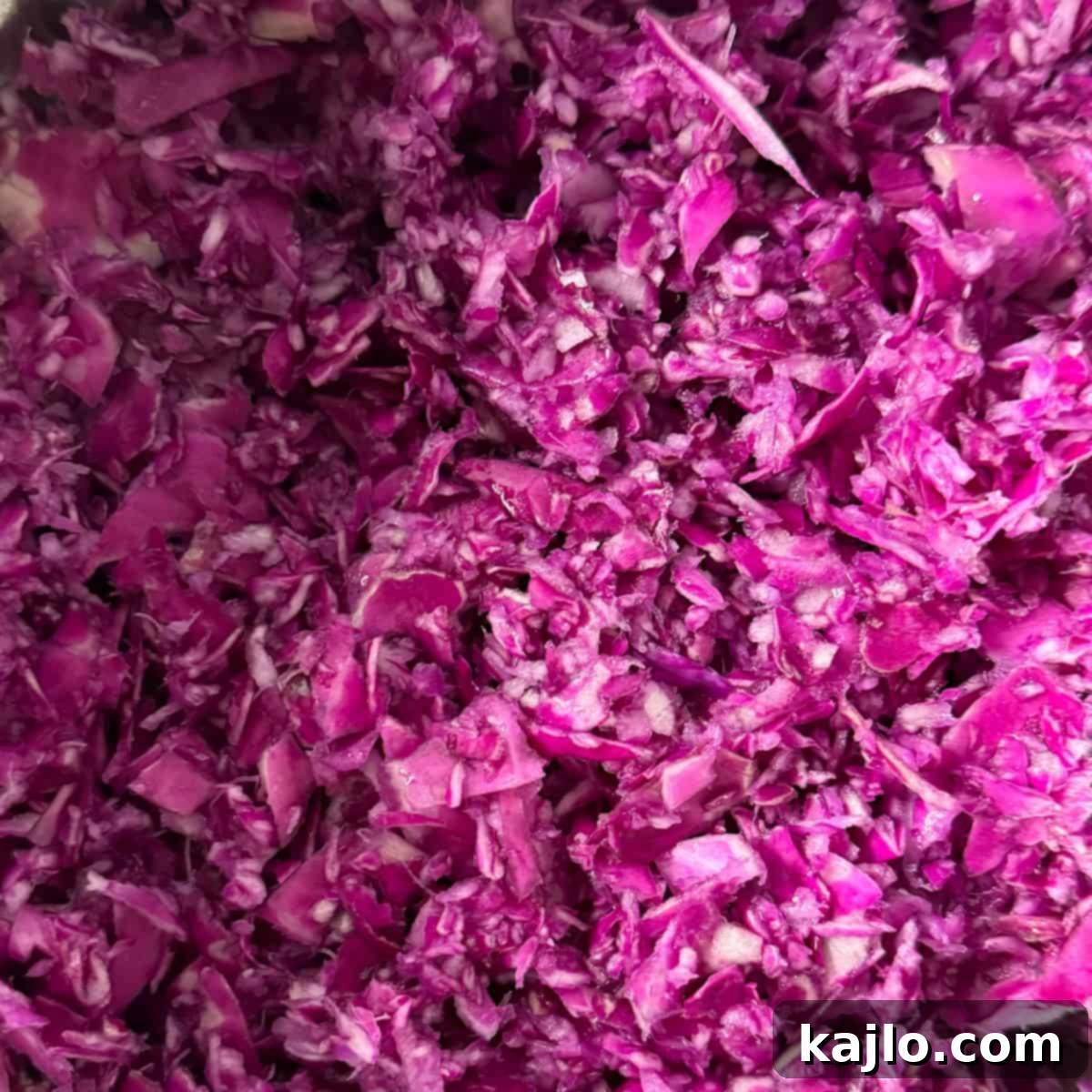
Transfer the shredded cabbage to a large, clean bowl. Sprinkle the pickling salt evenly over the cabbage. Now, the real work begins: vigorously stir and pound the cabbage for at least 10 minutes. This mechanical action, combined with the salt, will draw out the natural liquids from the cabbage, forming a salty brine. You should see a significant amount of liquid accumulating at the bottom of the bowl.
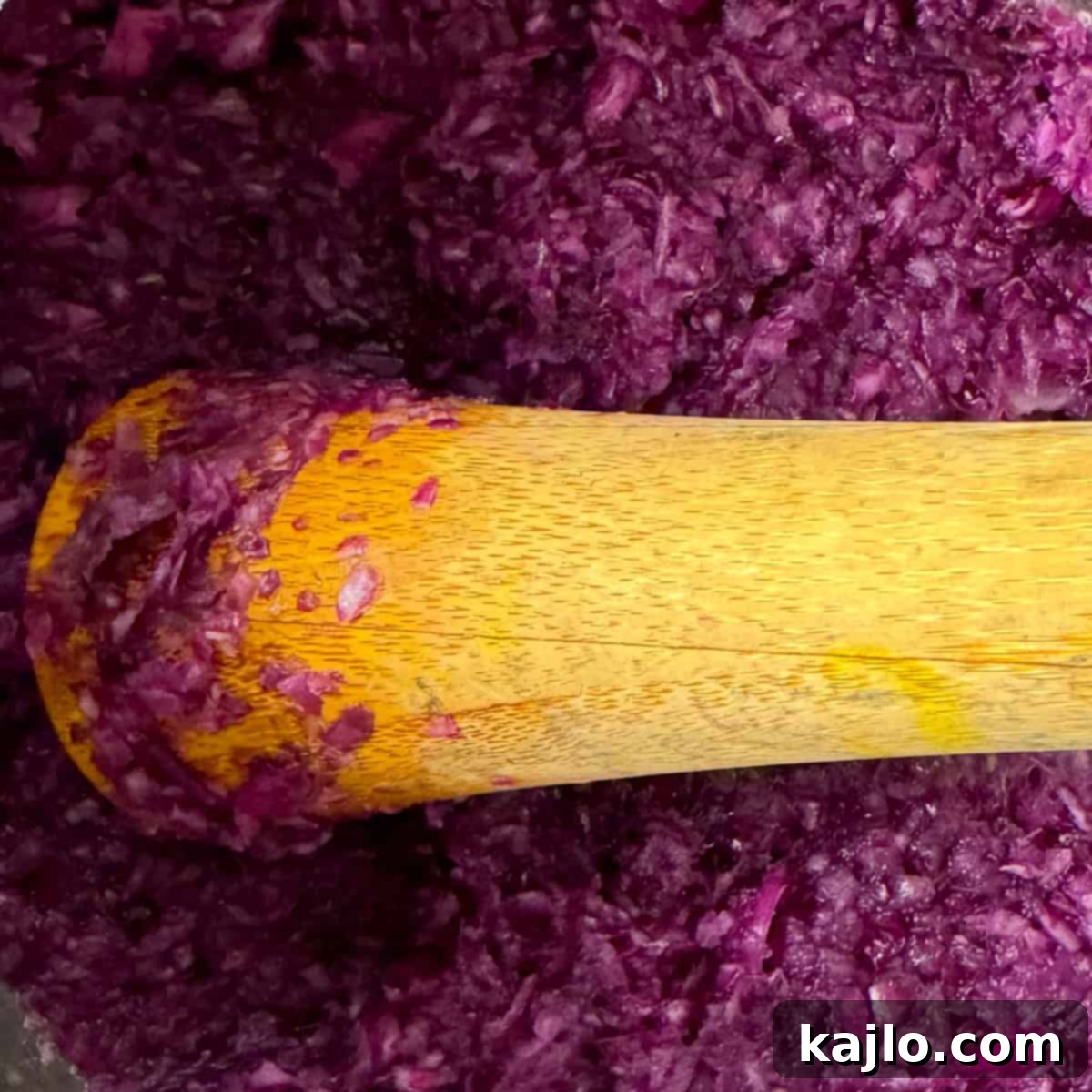
Once you have a good amount of brine, stir in the dried juniper berries and caraway seeds. These are optional but contribute significantly to the traditional sauerkraut flavor. Feel free to experiment with other spices like peppercorns, ginger, garlic, turmeric, mustard seeds, or dill if you wish.
Begin packing the cabbage very tightly into your wide-mouth quart mason jar. Use a wooden tamper or a sturdy implement to press down firmly, eliminating any air pockets and ensuring the cabbage is submerged under the brine. Place the outer cabbage leaves you reserved earlier on top of the shredded cabbage to create a barrier, then position a jar weight on top of the leaves to keep everything firmly pressed below the brine level.
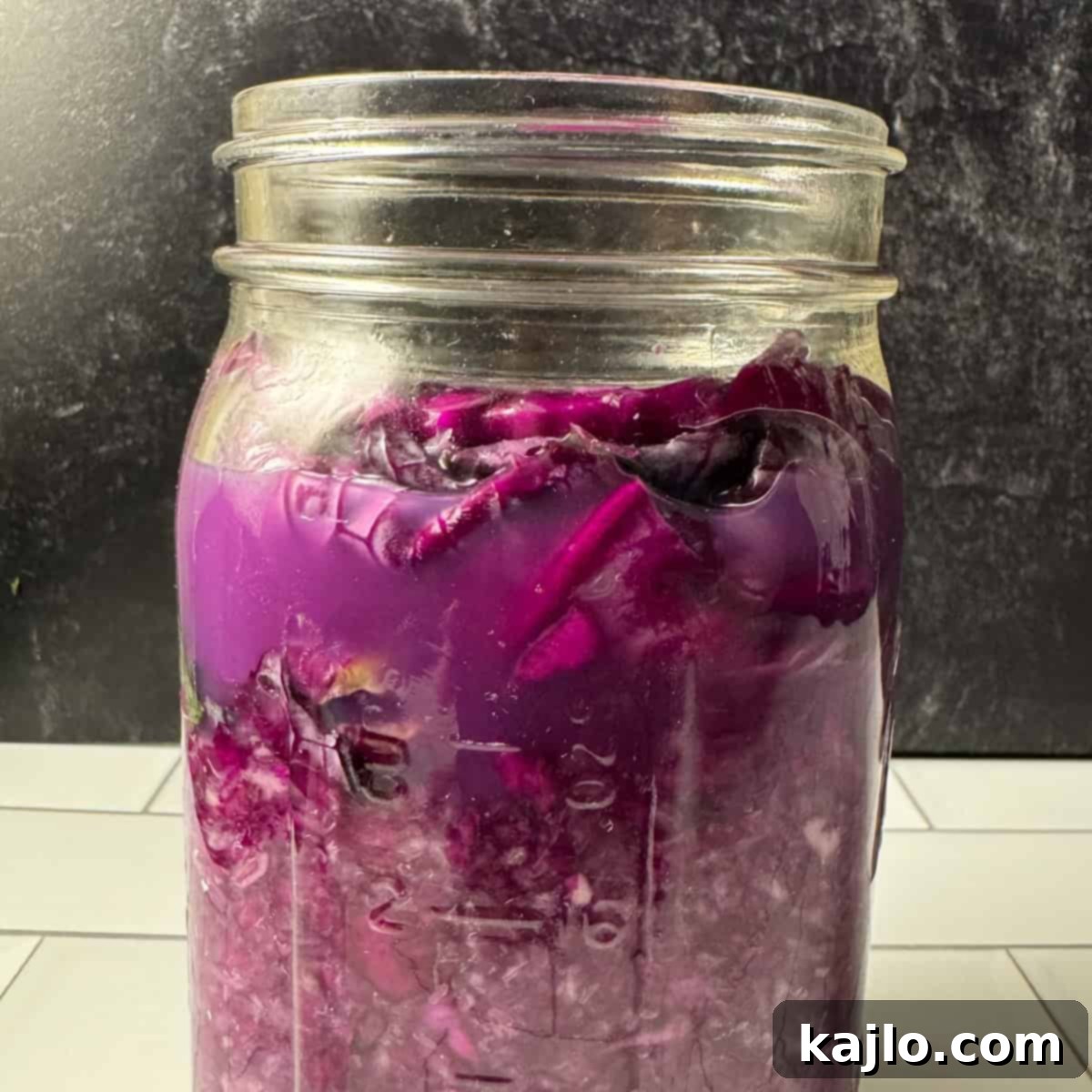
Double-check that all the shredded cabbage is completely submerged below the level of the brine. If there isn’t enough liquid to cover the cabbage, you can prepare additional brine by dissolving 1½ tablespoons of salt in 4 cups of water. Add just enough of this supplemental brine to ensure full submersion, then re-apply your weight.
Secure the airlock lid onto the jar. Place the jar in a location where it can ferment at a consistent room temperature, ideally around 70°F (21°C). A slightly cooler temperature will slow down fermentation, while warmer temperatures will speed it up. Avoid direct sunlight. If your environment is too cool, a heating pad set on its lowest setting can provide a gentle warmth to encourage fermentation.
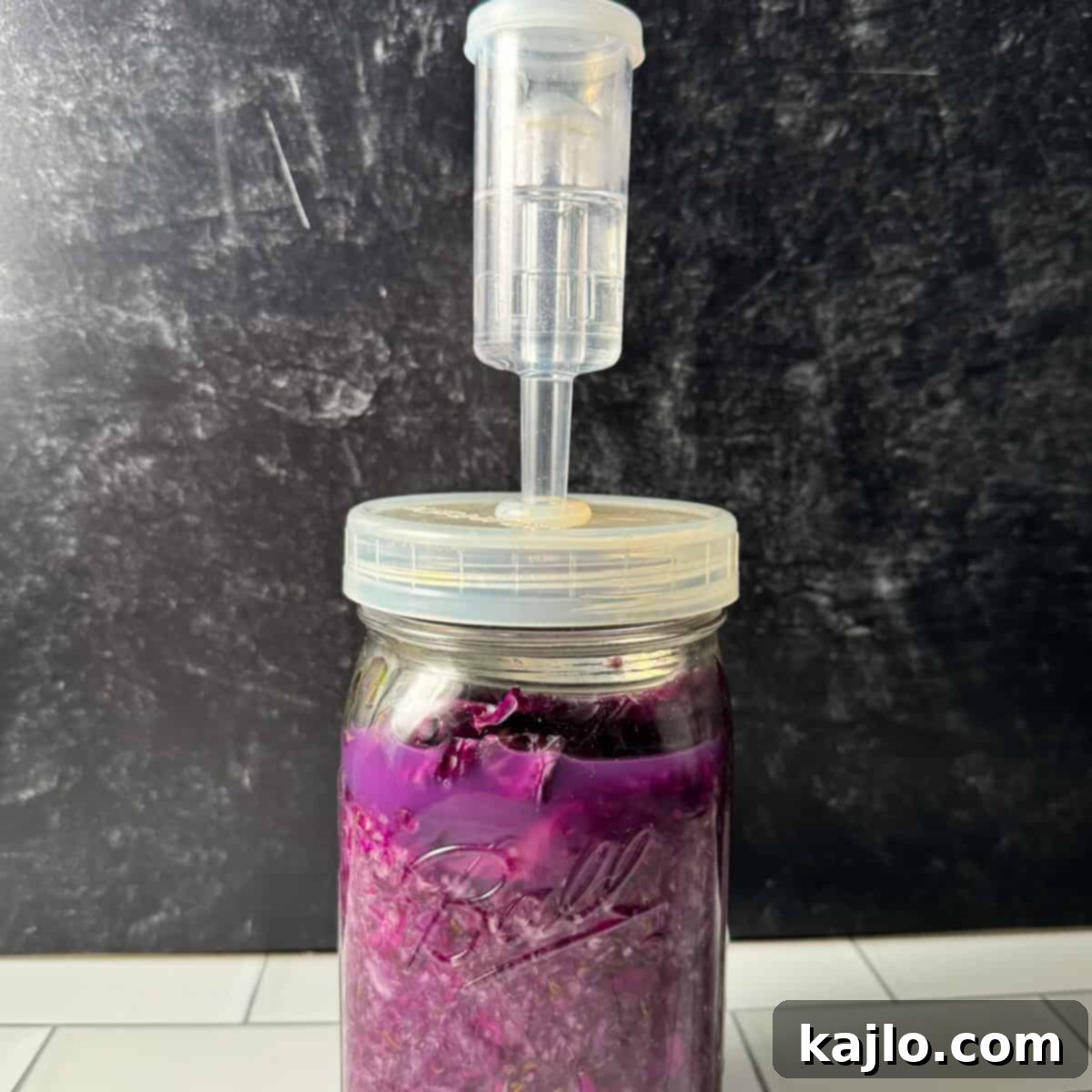
Inspect the jar daily. It’s common for foam or a thin, white “scum” (often kahm yeast) to form on the surface of the brine. This is generally harmless, but it’s best to open the jar, skim it off with a clean spoon, and replace the lid. Ensure the cabbage remains submerged; if the brine level has dropped, add a little more of your prepared brine. The red cabbage will also begin to change color, becoming a brighter pink-red as it acidifies, indicating that fermentation is progressing successfully.
The fermentation period can range from three days for a milder kraut to up to six weeks for a more intensely tangy flavor. For a balanced taste, I typically ferment my batches for about five days. Taste a small amount of sauerkraut after three days, and continue fermenting until it reaches your desired level of tanginess and texture.
Once fermentation is complete, remove and discard the outer cabbage leaves and the jar weight. Replace the airlock lid with a regular canning jar lid and rim. Transfer your finished sauerkraut to the refrigerator for storage. To maintain its quality and prevent spoilage, keep a jar weight in the jar to ensure the sauerkraut remains pressed below the brine level.

Fermented Cabbage Tip: Managing Excess Brine
If your cabbage was particularly juicy, you might notice a significant amount of liquid release after a day or two. If your jar seems on the verge of overflowing, you can carefully pour off a small amount of the excess liquid. Just remember to always ensure the shredded cabbage remains fully submerged beneath the brine to prevent mold formation.
Is pickled red cabbage the same as sauerkraut?
While often used interchangeably, traditionally fermented sauerkraut and quick-pickled red cabbage are distinct. Pickled red cabbage, sometimes called “quick red cabbage sauerkraut,” is made by preserving cabbage in vinegar, offering a tangy flavor almost instantly. However, it bypasses the slow lacto-fermentation process that cultivates beneficial probiotics. True sauerkraut relies solely on salt and time for its transformation. If you’re looking for a quick vinegar-pickled red cabbage recipe, you can find one here.
🌡️ Fermented Cabbage Storage
Proper storage is key to enjoying your homemade fermented red cabbage for an extended period and preserving its valuable probiotic content. Once fermentation is complete, transfer your sauerkraut to the refrigerator. Stored correctly, homemade fermented red cabbage can last in the fridge for up to 3 months. This cold storage effectively slows down the fermentation process, keeping the beneficial probiotics largely intact, unlike hot bath canning which would destroy them.
I personally enjoy a spoonful of this tangy ferment occasionally as a low-calorie snack or as a lively side dish with my main meals. If you find the sauerkraut’s saltiness a bit too intense for your palate, you can give it a quick rinse under cold water before serving. Be aware, however, that rinsing will also wash away some of the surface probiotics along with the excess salt.
A crucial reminder: whatever you do, do not reduce the salt content in the initial recipe! As highlighted earlier, the precise salt concentration is essential for creating the correct osmotic pressure that inhibits undesirable bacterial growth and fosters a safe fermentation environment. Skimping on salt can lead to unwanted microbial activity and spoil your entire batch.
Always inspect your sauerkraut for any signs of spoilage before consuming. A funky, unpleasant odor, unusual sliminess, or an off-color (such as brown, green, or black patches indicating mold) are clear indicators that your red cabbage ferment has spoiled. If any of these signs are present, it is safest to discard the entire batch.
Watch How to Make It!
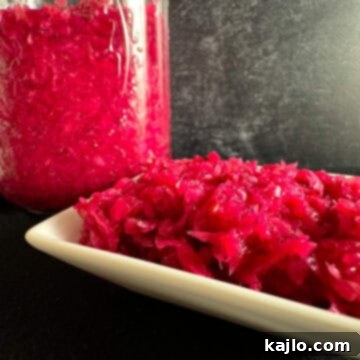
Fermented Red Cabbage Sauerkraut Recipe
Summer Yule
You can make this vibrant fermented red cabbage sauerkraut at home with just cabbage and salt; no starter culture is needed. It’s delicious and fits most special diets!
Print Recipe
Pin Recipe
Ingredients
- 23 ounces red cabbage (652 grams; about 1 small head; save an outer leaf or two)
- 1 tablespoon pickling salt or finely ground sea salt (not iodized salt)
- 8 juniper berries (dried)
- ½ teaspoon caraway seeds
Please leave a comment below 😊
Instructions
- Important! Please read the post accompanying this recipe before you begin. It contains essential equipment and food safety information that you do not want to miss.
- Wash and sanitize your metal and glass equipment thoroughly before you begin. I did not use a boiling water bath to sterilize the equipment, as we are not fermenting in an anaerobic environment nor canning the sauerkraut. I accidentally broke a jar weight in a boiling water bath once, so please be careful!
- Core and shred your cabbage. I used the grating plate on my food processor to save time with this step. The finer you shred your cabbage, the faster it will ferment.
- Put your cabbage in a large bowl and sprinkle with the salt. Stir and pound the cabbage for at least 10 minutes. The cabbage should release a lot of liquid, creating a salty brine.
- Stir in the juniper berries and caraway seeds. (No worries if you do not have these, they are optional but nice.)
- Pack the cabbage very tightly into a glass mason jar. Press the cabbage beneath the brine with the outer cabbage leaves you set aside earlier. Put a jar weight into the jar to keep everything down.
- The cabbage should be submerged below the level of the brine. If not, you can make additional brine by mixing ¾ tablespoon salt per 2 cups of water.
- Put the airlock lid on the jar. Leave the jar at room temperature to ferment (approximately 70°F/21°C.) My house is a little cooler than this at this time of the year, so I snuggled the jar next to a heating pad on the lowest setting.
- Important! Check the jar daily. Open it and skim off any foam or “scum” that has formed on top of the brine. Replace the airlock lid when you have finished. You can also add more brine if needed, but this will likely be unnecessary if you use the airlock lid.
- Your sauerkraut will be ready in three days up to six weeks. I let my batch ferment for five days. Let yours ferment longer if you’d prefer a more tangy sauerkraut.
- When it is finished fermenting, discard the outer leaves. Store your sauerkraut in the fridge with a regular canning jar lid and rim. Keep a jar weight in the jar to keep the sauerkraut pressed below the level of the brine. This recipe makes approximately three cups of sauerkraut, or twelve ¼-cup servings.
Equipment
- Food Processor
- Wide-Mouth Quart Jar
- Fermenting Kit
Notes
💭 Expert Tips from Dietitian Summer Yule
This is a level 1 recipe (may help support fat loss). Red cabbage sauerkraut is a low-calorie food that is rich in beneficial phytochemicals (such as anthocyanin) and prebiotics. Plus, it’s an excellent source of vitamin C and vitamin K. Unless you have certain medical contraindications (e.g., needing to be on a low-sodium diet), consider adding this ferment to your meal plan.
To eat fermented red cabbage, remove the jar weight and scoop the cabbage out with a fork. You’ll leave the brine (and much of the sodium) behind. To reduce the sodium further, you can rinse the sauerkraut before eating.
Is fermented red cabbage low FODMAP?
According to Monash University, red cabbage is low in FODMAPs. German red cabbage sauerkraut (AKA rotkohl or German sweet and sour cabbage) is typically made with a sweetener and is moderate in FODMAP.
Nutrition information is for one serving. Actual sodium content consumed will likely be lower than what is listed, as brine is typically not consumed.
nutrition info disclaimer
All recipes on this website may or may not be appropriate for you, depending on your medical needs and personal preferences. Consult with a registered dietitian or your physician if you need help determining the dietary pattern that may be best for you.
The nutrition information is an estimate provided as a courtesy. It will differ depending on the specific brands and ingredients that you use. Calorie information on food labels may be inaccurate, so please don’t sweat the numbers too much.
“To taste” means to your preferences, which may have to be visual to follow food safety rules. Please don’t eat undercooked food x
Nutrition
👨🍳 Red Cabbage Sauerkraut Serving Suggestions
Red cabbage sauerkraut is incredibly versatile and can elevate a wide array of dishes with its tangy, savory profile. Here are some fantastic ways to incorporate your homemade ferment into your meals:
- Classic Pairings: Serve it alongside traditional German or Eastern European dishes like Air Fryer Kielbasa, Air Fryer Pierogies, or Air Fryer Brats. Its acidity perfectly cuts through rich meats.
- Sandwiches & Burgers: It’s a natural fit for hot dogs with mustard, a classic Reuben sandwich, or even enhancing a hearty Elk Burger.
- Salads & Bowls: Add a zesty kick to a Keto Big Mac Salad Bowl or any green salad for a probiotic boost and vibrant crunch.
- Roast Meats: Pair it with roasted pork dishes like an Air Fryer Pork Shoulder Roast for a delicious contrast in flavors.
- Creative Combinations: Fermented red cabbage also complements a variety of fruits and vegetables, including roasted beets, fresh apple slices, caramelized onions, shredded carrots, fennel, and green beans. Try serving it with homemade unsweetened applesauce and roasted sweet potatoes for a well-rounded meal.
👨🏾🍳 Explore More Fermented & Pickled Delights
If you’ve enjoyed the journey of making red cabbage sauerkraut, you might be keen to explore other delicious and healthy fermented or pickled foods. Expand your culinary repertoire with these exciting recipes:
- Fermented Lemons: A zesty, versatile ingredient perfect for Moroccan dishes or brightening up salads.
- Middle Eastern Pink Pickled Turnips: A vibrant, tangy condiment often served with falafel and other Mediterranean fare.
- Refrigerator Dill Pickles: Quick and easy pickles that deliver a crisp, dilly crunch without traditional canning.
- Oat Milk Yogurt Recipe: A dairy-free, probiotic-rich alternative that’s surprisingly simple to make at home.
Join our community! Subscribe for all of the latest and greatest recipes, and follow me on Facebook, Pinterest, Instagram, and YouTube!
